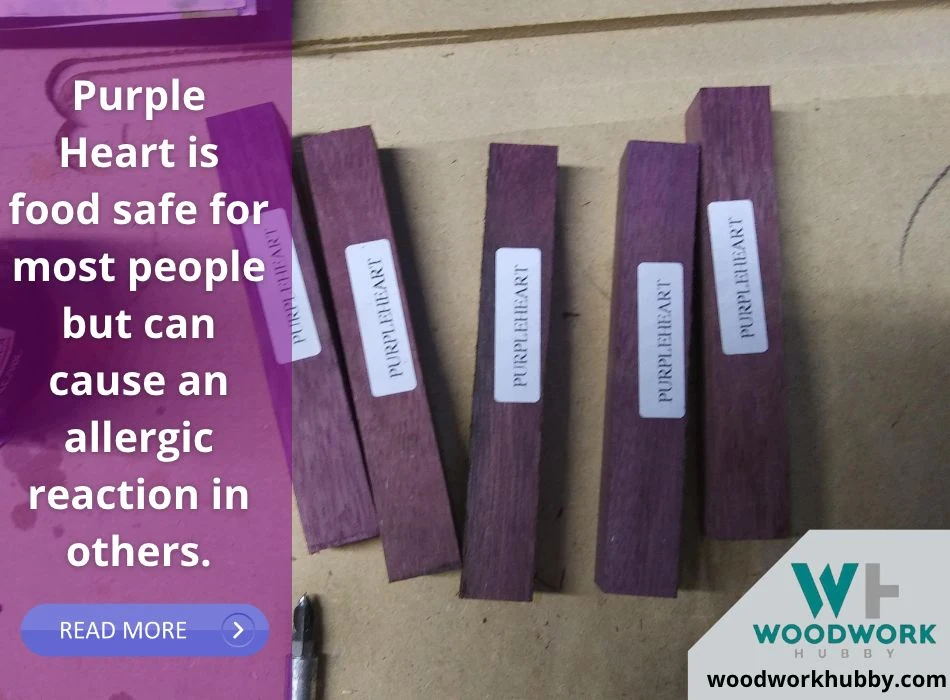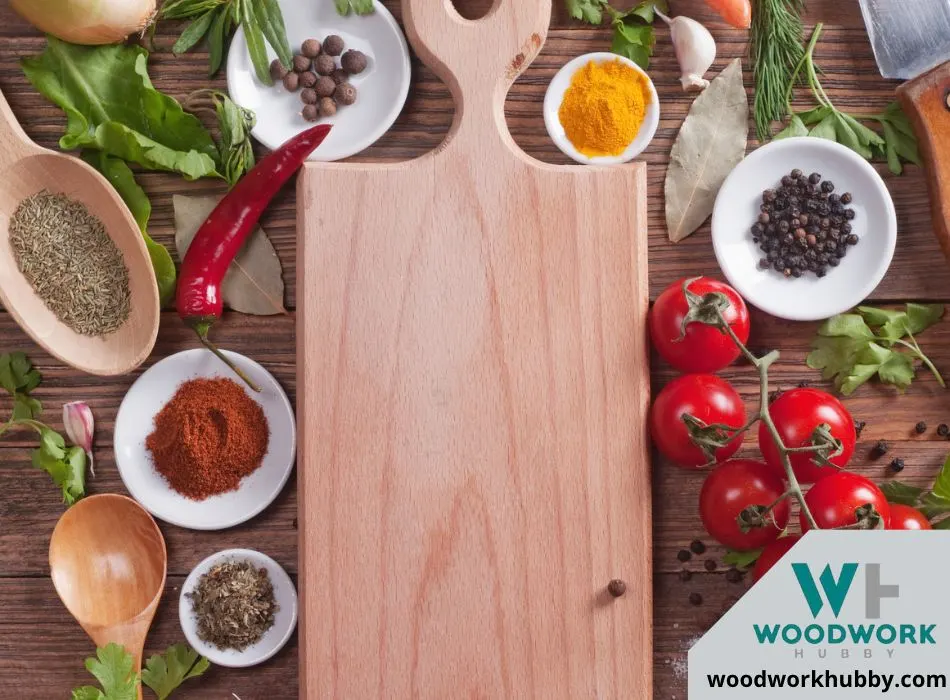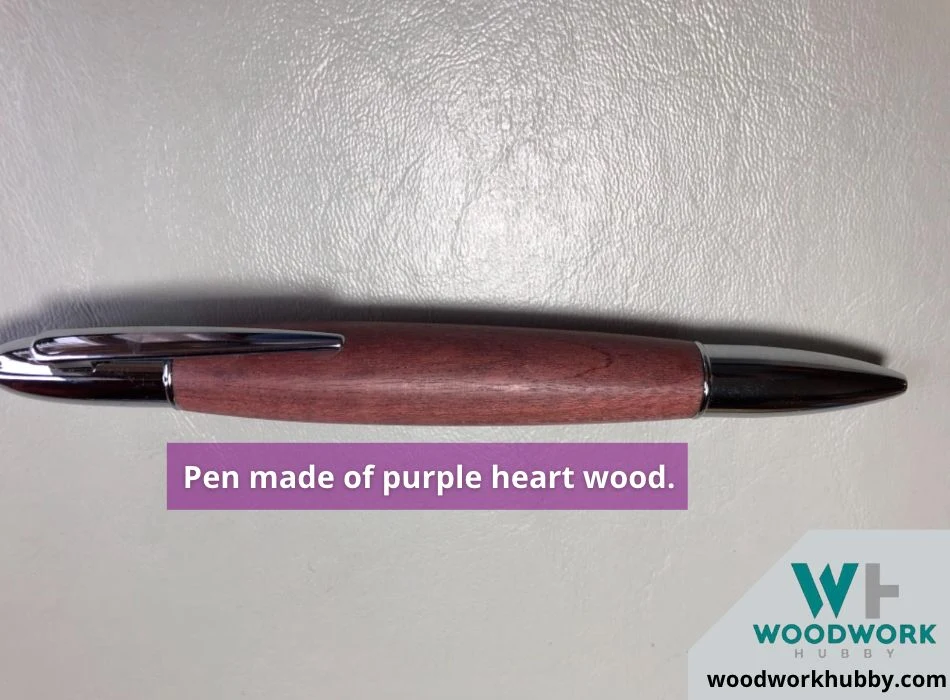Purple Heart wood is Brazilian-origin lumber with one of the highest Janka hardness ratings in the world. It has a purple core that darkens over time and an interesting consistency and texture. Quite obviously, it has many applications.
Purple Heart is food safe for most people but can cause an allergic reaction in others. This makes it less ideal for food-adjacent uses like cutting boards and wooden bowls. Still, food-safe projects can be made from it as long as it is finished with a non-toxic film.
In this article, you will discover the different uses of purple heart wood alongside its alternatives and compatibility with different kinds of projects. By the end, you will know where you should use purple heart wood and where a different type of lumber would be better. Let’s start with food-adjacent projects.

Can Purple Heart Wood Be Used for Cutting Boards?
One of the biggest questions that follow an inquiry regarding any type of wood’s food safety is its possible use in making cutting boards. Purple Heart is no different. Its strong core and scratch-resistant surface make it a good theoretical choice for cutting boards.
But is it a safe choice?
Purple heart wood can be used on a cutting board if it is coated in an appropriate food-safe finish. An unfinished purple heart cutting board can incur water damage and can cause skin irritation to some individuals.
Purple heart wood is generally safe, but there are enough instances of people developing allergic reactions to the lumber that it is currently classified as a sensitizer. That means it has the capacity to cause allergic reactions.
These generally materialize in the form of irritation in the eyes and redness of the skin. Does that mean using a purple heart cutting board will make you sick? Not really. It just means that if you are crafting a cutting board or any project out of purple heart wood, you might end up having an allergic reaction to the sawdust from it.
Since purple heart cutting boards are already being sold, it is pretty clear that this wood can be used for food-adjacent projects. If you are not personally allergic to purple heart wood, then feel free to make a cutting board out of it for personal use. In case you want to make projects to sell them, you have the responsibility to use hypoallergenic wood types.
And if you use purple heart wood, make sure that you use a food-safe finish over it.

Cutting boards generally require a food-safe finish or a coat for protection from water damage. Some cutting boards don’t require a surface-covering finish. They can make do with Tung Oil and similar rubbing oils. Purple Heart cutting boards need to be covered in “film building” finishes.
Not only does the coating finish build a film that protects the purple heart wood’s peculiar color from getting lost to exposure, but it also prevents the wood material from triggering an allergic reaction.
Why Is Purple Heart Toxic?
Purple Heart wood is not toxic but is a very likely allergy trigger because some individuals’ skin can react sensitively to purple heart mass. It is classified as a sensitizer for this reason. Woodworkers’ eyes and skin can get irritated from making contact with purple heart wood.
That is why purple heart wood’s sawdust is treated as toxic. Purple heart wood is not technically toxic, though. If it were, it would not be used as widely in construction.
I have not had an allergic reaction to purple heart wood, but I use a respirator when woodworking and my workshop has a good air filtration system.
Best Practices of Using Purple Heart Wood:
One of the most important aspects of woodworking is selecting lumber. If you only have one type of wood, you might find ways to shoehorn it into every project.
A video showing purple heart wood projects and finish.
One of the most important aspects of woodworking is selecting lumber. If you only have one type of wood, you might find ways to shoehorn it into every project. But lumber and project compatibility is critical for success.
Here are the best practices that will help you avoid disappointment when working with purple heart wood.
- Use it for furniture projects – Both indoor and outdoor furniture projects are excellent choices as they benefit from purple heart lumber’s durability.
- Avoid crafting projects with prolonged skin contact – While purple heart wood is used in some jewelry and tool projects, it requires an appropriate film finish.
- Work with purple heart wood once you have a respirator – A respirator like TANGS Half Face Cover Respirator can prevent lung and throat irritation from its sawdust.
What Is Purpleheart Wood Used For?
When talking about purple heart wood in the context of food-adjacent projects like cutting boards, cheese trays, and bowls, one has to highlight the potential of this lumber to cause irritation. From reading that, it might seem like purple heart wood is too toxic to be used for any project.
That’s far from the case. I’ve used it multiple times in my 20 years of woodworking.
Purpleheart wood is used for projects that require durable lumber. This includes indoor and outdoor furniture as well as flooring. It can be used in cabinetry as well. Another prominent use of purple heart wood is for instrument inlay and interior of different types of casings.

Ultimately, the greatest advantage of this wood is its durability. And any project that needs durable lumber can be made from purpleheart wood. However, if said project also comes in prolonged contact with human skin, alternative lumber might be a much better option.
Cherry and Walnut can be excellent alternatives for indoor use. Projects like side tables, cabinets, and desks can be made from walnut or cherry wood instead of purple heart lumber.
Outdoor uses can be derived from cedar if you don’t want to use Purple Heart. Cedar, Cherry, and Walnut are not as likely to cause an allergic reaction as Purple Heart.
Are any of these choices as tough as Purple Heart? Not even close. While Cedar, Cherry, and Walnut hover around the 1000 mark on the Janka scale, Purple Heart has a Janka hardness of 2710. It is much tougher than cherry and cedar.
Padauk is an African wood that comes close (1725 – Janka hardness). But it is not as widely available as cedar and walnut.
Can You Use Padauk Wood for a Cutting Board?
Padauk wood can be used for cutting boards, but in very rare instances, it too can be a sensitizer and cause similar allergic reactions to those caused by purple heart wood. A hypoallergenic film-building finish would offset this possibility. So overall, there is no harm in using Padauk.
The person who is at the highest risk of an allergic reaction is the woodworker cutting into Padauk. If the sawdust doesn’t irritate his lungs, throat, or eyes, the finished cutting board won’t irritate general consumers. Purple Heart is more likely to cause an allergic reaction compared to Padauk.
Padauk is rot-resistant, which is a very big plus in this context. Cutting boards can get wet quite often, and wet wood usually gets moldy. Rotting wood can be repaired in other applications.
But when it comes to food-adjacent projects like bowls, trays, and cutting boards, even a hint of rot renders a project useless.
Moreover, Padauk is extremely durable, which means heavy knife action will not affect it as much. That said, the finish used over it must be just as tough against knife movement. Otherwise, Padauk can be exposed and come in contact with food. As mentioned earlier, that can cause an allergic reaction in some cases.
What Wood Should Not Be Used for Cutting Boards?
On average, wood that is toxic or porous should not be used for cutting boards. Moreover, soft lumber is also not fit for the function of a cutting board. Cutting board wood is supposed to be strong with as closed a texture as possible and low odds of causing an allergic reaction.
I have compiled a list of all the wood types that should not be used for cutting boards.
- Cedar
- Juniper Pine
- Balsa
- Douglas Fir
- Mahogany
- Oak
- Ash
- Butternut
It is obvious why toxic wood would be bad for a cutting board: the food items being chopped over a toxic cutting board would be toxic! But why is porous wood bad? Because pores can absorb water and food essence. Particles of food that get lodged into wood pores can rot. To avoid contamination risk, cutting boards should be non-porous.
To avoid contamination risk, cutting boards should be non-porous.
Finally, wood softness can be a liability in cutting boards because soft lumber can wear out quickly. While this description seems pretty straightforward, it excludes many options. Most strong woods have open grain, and ones that are non-porous are toxic or too soft.
Pine, Birch, and Rosewoods are toxic. So which wood is ideal for cutting boards, then?
Maple is the best type of wood for cutting boards because it is generally non-toxic, close-grained, and sufficiently hard. There are different types of maple, and the best among them is sugar maple or hard rock maple. It is certified non-toxic, and its Janka hardness rating of 1450 is more than sufficient for frequent knife action.
Is Purpleheart Wood Strong?
Purple heart wood is among the strongest common-use lumbers in the world. It has a Janka hardness higher than that of Oak, which is generally used as a standard for strong woods. There are no doubts about the durability of purple heart wood. Its usage is limited by other factors.
- Color – Purple heart wood is adopted for its color, among other reasons. However, light exposure darkens it to a much less exotic tint, even indoors. Preserving film finishes are used to delay this outcome.
- Allergic Reactions – Purple Heart wood can irritate the skin upon repeated contact. This is not a guaranteed result but happens enough to make the matter of using this wood a touchy one.
- Availability – Purple heartwood has become far more available now than it used to be when I started woodworking over 20 years ago. Still, it is not as common as oak, maple, and walnut.
Despite the factors covered above, purple Heart is adopted in projects that require high structural integrity. This wood’s durability beats its limitations even in food-adjacent applications. Some woodworkers manufacture purple heart bowls and cheese trays. Of course, they coat it with a food-safe film finish.
Is Purple Heart Wood Toxic to Humans?
Purple Heart is not toxic but can act as an allergen to a decent number of humans. It requires repeated exposure before it causes redness, itchiness, and irritation. The following table explains the effect of purple Heart in different contexts.
| Situation | Effect | Probability |
|---|---|---|
| You touch purple heart wood | Your skin gets red | Low and with repeated exposure |
| You consume a particle of purple heart wood | Upset stomach, internal inflammation | Medium. |
| You inhale a particle of purple heart wood | Your throat gets irritated, and you have difficulty in breathing | High. |
| A particle of purple heart wood gets into your eye | Your eyes get red and itchy | High. |
Final Thoughts – Is Purpleheart Food Safe?
Purple Heart wood is food safe for some people and allergy-causing for others. For practical purposes, it is best to assume that this wood is not safe for cutting boards, bowls, and spoons. However, you can use it in these applications if it is coated in a food-safe film-building finish.
| Recommended products made of purple heart wood | Where To Buy? |
|---|---|
| Divit Shilp Streamline Ergonomic Handle Crochet Hooks | AMAZON |
| Breezelike Hair Combs – Fine Tooth Purpleheart Wooden Tail Comb | AMAZON |
| Purpleheart, 3″ x 6″ x 6″ | AMAZON |
| LIZD 2 Pairs(4PCS) Purpleheart Wood Ear Gauge Stretcher Plug | AMAZON |



